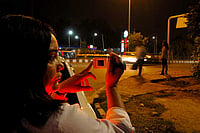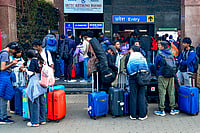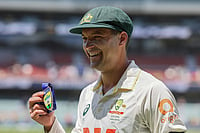Sunshine Lost?
Checklist of symptoms
- Joint pain
- Backache
- Skin irritation
- Chronic fatigue
- Low immunity
- Depression
- In children: Frequent fractures, muscle cramps, dental deformities
What sunshine vitamin prevents…
- Diabetes
- Rickets
- Cancer
- Cardio-vascular
- disorders
- Ostoeoporosis
***
Urban Indians are going out on a limb to avoid the sun—and depriving themselves of the sunshine vitamin in a country that gets copious doses of sunlight. Fundamentally, the problem is a lifestyle that is increasingly moving indoors, with even vegetables being ordered online and almost all exercise confined to air-conditioned gyms. Indeed, few would have suspected that in a tropical country like ours, acute Vitamin D deficiency would strike as the next lifestyle epidemic. Yet, here it is, silently taking down not just women, as was generally assumed, but infants and teens in alarming numbers.
It’s easy to miss the warning signs. The symptoms are relatively mild and generalised—fatigue, minor skin conditions like dryness, pain in the joints—and therefore ignored. So the deficiency often goes unnoticed unless a patient’s blood is specifically tested for it. Urja Shah, 56, a Mumbai-based housewife, in fact, discovered it accidentally. “Urja came to me with a bad case of psoriasis, a condition in which the skin flakes off,” says Dr Swati Srivastava, a VLCC dermatologist. “On an impulse, I advised her to get tested for Vitamin D, and it turned out that she was highly deficient, leading to severe dry skin, muscle cramps and spine pain.” Urja says she felt as if she’d lost some height as well, which was quite diconcerting. “I couldn’t reach a shelf in my home that I could easily reach earlier. For a good part of the last three years, I felt extremely weak. I did not feel fresh when I woke up. And I hardly had an active routine because I wasn’t up to doing anything at all.”

(Photograph by Apoorva Salkade)
Urja Shah, 56, Mumbai
“Till a month ago, I wouldn t step out of the house in the day, and used sunblock when I did. I’ve changed my lifestyle completely.”.
She has been prescribed 6 lakh IU (International Units) of Vitamin D a week, which she takes orally. Urja has since stepped up to reform her lifestyle, with daily exposure to the sun, supplemented by a regular dose of Vitamin D. “Now that I’m aware that so many of my ailments are linked to Vitamin D deficiency, I’m taking no chances. I’ve increased my intake of fruits and dairy products as well. Apart from trips to the market around noon, at home, I make sure to park myself at a spot where the sun streams in. And I haven’t touched my bottle of sunscreen,” says Urja.
A worrying lack of the sunshine vitamin has been lurking in the shadows for a while, but “urban Indians are just waking up to it”, says Dr Anoop Misra of Fortis Hospitals. A slew of recent studies corroborate the trend, with numbers daunting enough to set off warning bells everywhere. But it is not just an urban phenomenon. An AIIMS study done early this year says 80-90 per cent of adults and 70 per cent of children in India are Vitamin D-deficient, with teens and infants at an increased risk. In a study of a group of mothers and their infants, researchers found 92.6 per cent mothers and 86.5 per cent infants highly Vitamin D-deficient.
So it’s hardly surprising that Dr Sujeet Jha, an endocrinologist at Max Healthcare, prescribes Vitamin D supplements to practically every patient who comes to him. “Unlike in the West, fortified milk and fish is not a regular part of the diet in India. In addition, these days, bone weakness, cases of diabetes and bodyaches have all become increasingly common, and this calls for patients taking Vitamin D supplements,” he says.
Not just that, a new study proves that Vitamin D, which is actually a pro-hormone that is produced upon exposure to the sun, holds the key to prevention of diabetes and heart disease. “Patients with low Vitamin D levels have less secretion of insulin,” says Dr Misra, quoting the study led by him, conducted by the Diabetes Foundation (India), the department of diabetes and metabolic disease at Fortis Hospital and the department of biostatistics, AIIMS.
The main symptoms, acknowledge doctors, are pain in the joints, backache, and weakness. All of which Ayeda Ravindran, 40, who runs a stress management and performance coaching company in Bangalore, complained of. “Ever since I returned to India from the US, I have been low on energy, suffered from bouts of depression, and had frequent backaches, which affected my daily life dramatically. I was also not able to lose weight,” she says. The symptoms worsened even after repeated visits to doctors. “Awareness in India about the deficiency is so low,” she continues, “that they couldn’t prescribe the right medicine for me.”
Ayeda then decided to take matters into her own hands and educated herself about the condition on the internet, and got in touch with doctors at the American Vitamin D Council. “I was advised to take Vitamin D3 supplements, some 60,000 IUs a week, in the form of oral cholecalciferol. I now see a remarkable difference in my condition. I’ve been able to lose weight, mood swings are fewer, my skin feels good, and I have way more energy,” she says.
Ayeda, however, is in a minority. A growing breed of urban Indians seems to know little about the condition, while unknowingly falling prey to it. Blame it all on the modern lifestyle. Those of us who live in air-conditioned houses, go to work or school in air-conditioned cars and buses, shop in malls, and work out indoors are obviously at higher risk. That, coupled with an alluring array of products aimed at keeping the ultraviolet rays in sunshine from interacting with the epidermis, in the process generating Vitamin D—top-of-the-range artificial cooling, haute couture hats, protective clothing, and an endless supply of “new and improved” high-spf products that block out of the UV rays even if you do expose yourself to the sun. An accomplice to this is the deep-seated Indian obsession with “fair” skin. “The misconception today is that the sun is an enemy, and that it causes cancer. So people avoid stepping out in the sun unless armed with layers of sunblock. There is even sunblock for kids these days, and 5-year-olds are using it. When teenagers go out to play, parents tell them not to because they will get tanned!” says Dr Srivastava.
“It has become fashionable to stay out of the sun,” agrees Delhi-based physician Dr Anjan Roy, who recently treated an elderly lady with chronic joint pain, and found a marked difference in her condition after administering Vitamin D injections. “Everyone worries about getting tanned,” adds Dr Vandana Jain of AIIMS, “when in fact Asian skin needs about thrice the exposure to sun than white skin, because penetration is less in the former due to darker skin pigmentation. If you get even 15 minutes of the sun at the right angle (between 10 am and 4 pm), with head, face and half of your arms and legs uncovered, your body can synthesise enough Vitamin D.” But awareness about the deficiency in India is low, she says, adding that traditionally, infants were given an oil massage in the sun, but with the breakdown of the joint family, such practices have also faded.
With doctors only just waking up to this new lifestyle malady, few people get themselves tested for Vitamin D deficiency. Besides, the blood test for Vitamin D is relatively expensive (`1,000-1,700). But doctors say there are plans to make the test mandatory for patients with diabetes, obesity and joint pain. What’s still being debated, however, is exactly how much Vitamin D an average Indian requires a day (see box). Others, like Ayeda, are trying to spread the word. “It’s a Sunday ritual in my home to take Vitamin D3 supplement for the week, since I’ve got my parents on it too. Sunshine and Vitamin D supplements are good for treating ostoeoporosis too, since they help mobilise calcium in the body,” she says. The best way to prevent it? That’s an easy one, as Dr Misra says: “Get your moment in the sun.”


























